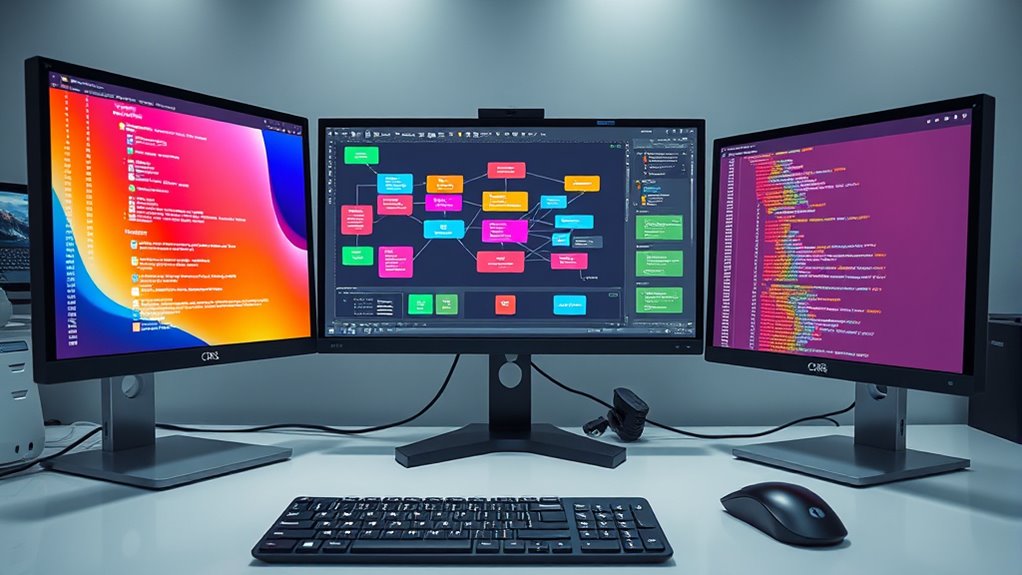By combining CQRS and Event Sourcing, you can create scalable and reliable data systems that clearly separate command (write) from query (read) operations. Commands handle business logic and generate events, which are stored in an immutable event store. Queries then use denormalized views built from these events, ensuring consistency and traceability. Understanding these patterns helps you design systems that are easy to maintain, audit, and scale—continue exploring to uncover how to implement them effectively.
Key Takeaways
- CQRS separates read and write operations, improving scalability and simplifying data management.
- Event Sourcing records all changes as immutable events, providing a complete audit trail and historical context.
- Combining CQRS with Event Sourcing enhances data consistency, integrity, and resilience across system components.
- Event Sourcing enables replaying events for recovery, analysis, and temporal queries, supporting complex data management needs.
- Proper design of event schemas and storage mechanisms is essential for efficient, scalable, and reliable data handling.

If you’re looking to improve your data management strategies, understanding CQRS (Command Query Responsibility Segregation) and Event Sourcing is essential. These patterns help you handle complex systems by clearly separating how your application processes commands and queries, leading to better scalability and maintainability. When you implement CQRS, you break down your system into two distinct parts: one responsible for commands that change data and another dedicated to queries that read data. This separation allows you to optimize each side independently, often resulting in faster response times and more straightforward code. For example, commands might trigger validations, business logic, and updates, while queries focus on retrieving data efficiently.
Event Sourcing complements CQRS by recording every change to your system as a sequence of events rather than just storing the current state. Instead of overwriting data, each event captures a specific action, creating an immutable log of all modifications. This approach makes it easy to reconstruct the entire state of an entity at any point in time, providing a detailed audit trail. When you combine CQRS with Event Sourcing, the command side generates events that describe what happened, and these events are stored persistently. The query side then reads from a denormalized view or read model built from these events, ensuring data consistency and integrity.
Using event sourcing, you gain several advantages. First, it simplifies handling complex business processes where understanding the history of changes is *vital*. You can replay events to recover from failures, debug issues, or analyze trends over time. It also enhances scalability because the event store can serve as a single source of truth, reducing data duplication. Additionally, event sourcing makes it easier to implement features like undo operations, auditing, and temporal queries, giving you more control over your data lifecycle.
However, adopting these patterns requires careful planning. You need to design your event schema thoughtfully, ensuring that each event provides meaningful context. You’ll also want to implement efficient event storage and retrieval mechanisms, especially as your system grows. When properly integrated, CQRS and Event Sourcing not only streamline data management but also provide a robust foundation for building resilient, scalable applications. By understanding these patterns and their interplay, you set yourself up to create systems that are both flexible and reliable, capable of adapting to evolving business needs with clarity and precision.
Frequently Asked Questions
How Does CQRS Improve System Scalability?
You improve system scalability with CQRS by separating read and write operations, allowing each to be optimized independently. This enables system partitioning, reducing bottlenecks and increasing capacity. Although it introduces eventual consistency, you gain faster processing and better load distribution. As a result, your system handles higher traffic more efficiently, ensuring smoother performance under heavy loads while maintaining data integrity across different components.
What Are Common Challenges Implementing Event Sourcing?
Implementing event sourcing can feel like steering through a dense forest—challenging but rewarding. You might struggle with event versioning, where updating past events becomes complex, and snapshot management, which helps optimize performance by capturing system states. These challenges demand careful planning and robust strategies, but overcoming them ensures your system accurately records every change while maintaining efficiency. With patience, you’ll turn this wilderness into a well-mapped trail.
How Do CQRS and Event Sourcing Impact Data Consistency?
You guarantee data consistency by separating read and write models, which helps maintain data integrity even during high loads. CQRS and event sourcing introduce some latency management challenges because updates are stored as events before updating the read model, but they also offer better control over consistency. This approach allows you to optimize for quick reads while preserving an accurate, reliable history of data changes.
Can These Patterns Be Integrated With Existing Systems?
Yes, you can integrate CQRS and event sourcing with your existing systems. Start by evaluating your legacy integration and system compatibility, then gradually implement these patterns to facilitate smooth transitions. You might need to adapt your current architecture or introduce adapters to bridge new components. By carefully planning the integration process, you’ll enhance your system’s scalability and flexibility while maintaining data consistency across your infrastructure.
What Are Best Practices for Testing Cqrs-Based Applications?
Did you know that 85% of successful software projects prioritize thorough testing? To guarantee your CQRS-based application performs well, focus on extensive unit testing for individual components and integration testing to verify interactions between command and query sides. Automate tests where possible, and simulate real-world scenarios to catch issues early. Consistent testing helps maintain system integrity, reduces bugs, and boosts confidence in your application’s reliability.
Conclusion
By adopting CQRS and event sourcing, you can confidently manage complex data, ensuring consistency and scalability. While some skeptics argue these patterns add complexity, evidence shows they streamline data flow and improve resilience. Embracing these approaches often reveals that their benefits outweigh the challenges, especially when you validate their effectiveness through testing. Ultimately, integrating CQRS and event sourcing can transform your data management, making your system more robust and adaptable to future needs.








